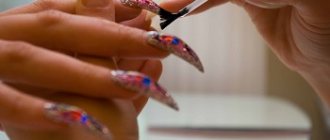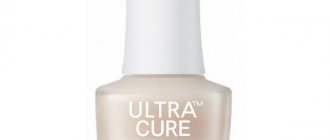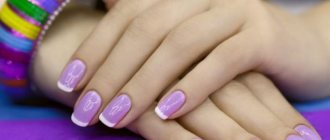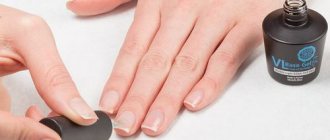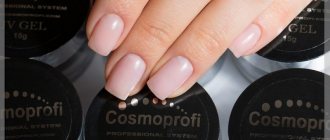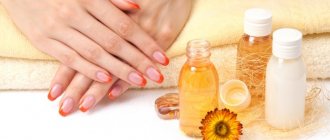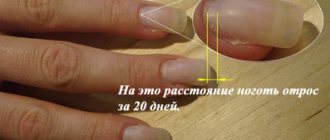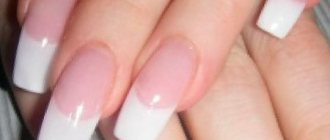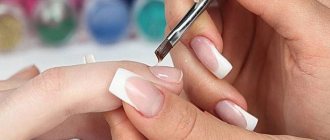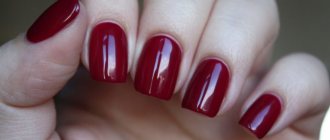Why does gel polish peel off?
The reasons for material detachment are quite varied, but much depends on the professionalism of the specialist. If the correct technology is not followed, the gel polish is removed as a film from the entire nail or may peel off at the edges. To avoid this, you must adhere to the following rules:
- apply all components of the gel system only to the nail plate (and remove anything that accidentally gets into these areas before polymerization), the gel polish moves away from the cuticle and side ridges when it gets on them;
- take into account the condition of the nails and the procedures performed on them (manicure and other care), use a degreaser and, if necessary, a dehydrator, do not apply shellac after steaming your hands or applying cosmetics containing fats and oils;
- follow the pre-grinding technology - if you do not remove the top shiny layer and the skin growing from the cuticle (pterygium) from the nail plate, this will not give the material reliable adhesion to the surface of the nail and is almost guaranteed to lead to its peeling; No less dangerous is excessive enthusiasm when filing - shellac will not stick to a thin and damaged nail, and recovery will take time;
- Do not ignore the “sealing” of the free edge of the nail plate on the sides and ends with a finishing agent.
Why does it hold up little and crack?
The reasons for cracking of gel polish on natural and artificial nails can be caused by external damage, failure to maintain such a manicure, and internal factors. The cause may also be an unsuitable drying lamp.
The following can lead to deformation of the coating:
- Mechanical loads leading to bending of the nail plate under gel polish. This coating is quite durable, it does not adapt to the “behavior” of the original plate, does not bend along with it, but simply cracks. Usually, subsequent problems with nails arise not because of the age-old question of whether gel polishes are harmful, but because of such injuries and careless wearing of the coating.
- Low temperatures can cause not only deformation or peeling of the coating, but also color fading.
- Incompatibility in the density of the components used for the procedure (gel, finish, base from different manufacturers). A natural elixir for healthy curls is fir oil for hair.
- Visiting the beach and places with high humidity (sauna, bathhouse, swimming pool).
- To a lesser extent, but also unsafe for the coating, staying in places with high temperatures, such as a solarium.
- Frequent contact with cleaning agents without protective gloves.
Sometimes the reason for the formation of cracks is a woman’s health problems and, as a result, rejection of gel polish:
- infectious diseases and various inflammatory processes in the body, affecting the condition of the nail plates;
- hormonal imbalances;
- taking potent medications, antibiotics, hormonal agents. Recipes for sunflower oil hair masks are presented here.
It is undesirable to do shellac during the menstrual cycle, as well as the first and third trimesters of pregnancy due to hormonal imbalance.
What to do if gel polish does not stick to your nails
In addition to minor peeling, the material may come off the nail plates completely. Why is this happening? The reasons may be similar to those listed above. But how can you protect yourself from such disappointments? Reply
Follow Coating Rules
Gel polish can shrink, slide off like a film, crack or chip if one of the coating layers is too thick or, conversely, insufficient. The first circumstance prevents the material from hardening completely, the second deteriorates its strength.
Don't mindlessly combine different products
The reason for shellac falling off can also be the use of products from different brands. This happens especially often when applied independently, since at home it is difficult to test all available materials for wearability. To protect yourself from such troubles, try to use the highest quality base and topcoat possible, but cheaper colored gels in many cases behave no worse than expensive ones.
Consider the functions of different types of tools
When preparing to apply gel polish, not only a primer that prepares the nail plate for the application of gel products can help, but also other specialized products. Be sure to use an antiseptic - this is a guarantee that an infection or fungus will not develop under the coating.
Think about your health
Many diseases and special conditions of the body can in some cases affect the nails:
- Endocrine diseases. Diabetes mellitus or thyroid dysfunction can change the structure of the nails so that the gel coating will not stick.
- Other painful conditions. When your body is fighting an illness, it often doesn't have enough resources for your nails. Taking antibiotics or other medications can interfere with your manicure. In this case, it is better for you to wait for recovery, and then contact a specialist.
- Problems with nails. Fungal infection and other diseases are an absolute contraindication to the application of gel coatings. The master must warn you about this and advise you to take care of your nails first, otherwise you will not only not get a long-lasting manicure, but can also seriously worsen their condition.
- Pregnancy and menstruation. Not every woman in this position is not suitable for shellac, but there are times when this interferes with a long-lasting manicure. As for other natural hormonal fluctuations, you can avoid the risk of detachment and chipping of the gel coating by waiting until the end of the cycle.
- Individual intolerance. This is an extremely rare occurrence, but if different products from different manufacturers and applied by different artists still don't last, the reason may be that your nails are simply rejecting foreign material.
If you have any of the above, do not rush to blame the master for the fact that the coating is peeling off.
Master's wines
Very often, nails begin to peel off quickly due to the fact that the creation technology was grossly violated during their manufacture. Most often this happens to those who do their own nail extensions at home. This is due to the lack of experience, skills and knowledge of the nuances, the inability to choose high-quality material, as well as the inconvenience of independent extension from a technical point of view. However, such violations can also be committed by unscrupulous craftsmen who skip any stages due to negligence or to save materials.
Usually, if it is for this reason that detachment occurs, then it is the most intense compared to other reasons. If you are wondering why extended nails fall off or why entire nail plates have already completely fallen off, then most likely this is the problem. Peeling for other reasons most often manifests itself as small air bubbles and cracks that have formed under the plate. There are a number of important nuances, if violated, the stability of the manicure is significantly reduced.
- Poor nail preparation, insufficiently polished nail;
- There is some old manicure left in the area near the cuticle;
- The plate was not treated with an antiseptic; as a result, bacteria penetrated under it;
- The skin of the prenail ridges or the cuticle was damaged;
- No primer or bond or degreaser was used;
- Problems in the architecture of the nail - the stress zone is poorly strengthened, the stiffening rib is not created, etc.
The last point may also be the reason why gel nail extensions break. This happens especially often with nails extended onto forms. If at least one mistake from the list above was made, then the nails may not last even a week on the fingers.
[yandex2] [google2]
Reasons why gel polish peels off at the ends
The cause of detachment near the free edge is often the following factors:
- Contact with water. In the first day or two after applying shellac, the process of polymerization—fixing and hardening of the material—continues, so do not get carried away during this period by taking baths, swimming in the pool, going to the sauna or bathhouse, as well as household work that involves long periods of bare hands staying in a humid environment . It doesn’t hurt to avoid doing the above a couple of days before you plan to do a shellac manicure.
- Aggressive environment. Protect your hands from contact with household chemicals and be sure to wear rubber gloves.
- Structure of the nail plate. Chipping and peeling of material at the tips of your nails can occur if your nails are peeling. You can avoid this if you carefully file and sand all the detachments before performing a manicure. Another reason for this unpleasant phenomenon may be flexible nails: the coating, despite its thickness, bends along with the free edge, cracks and chips. Here systematic care aimed at strengthening the nail plate will help you.
- Nails not long enough. If the pad of the finger comes into contact with the nail plate and extends over it (as happens, for example, in people who bite their nails), constant contact with sweat and sebum can lead to chipping and peeling.
Causes of cracked nails
There are various reasons for cracked nails. The most common cause is nutritional deficiency. A diet that is lacking in certain vitamins such as: C, A, B-12 can cause your nails to become brittle.
Folic acid is a vitamin that plays a role in the body's recovery mechanism. If the body does not contain enough of this element, it cannot synthesize proteins to produce healthy tissue. Consequently, nails become weak and brittle.
- Age. With age, the nail plate becomes thinner, which increases the chances of cracks. It is most common in women over 60 years of age.
- Nail polish and nail polish remover contain strong chemicals. With regular use, they weaken the nail plate.
- Excess or lack of water. Water can soften your nails, and repeated exposure can weaken them. Dehydration contributes to dryness of the nail plate and, as a result, the formation of cracks.
- Nail injury. As a result of impacts, injuries or strong pressure on the nail, cracks may occur. People who work with their hands (such as gardeners) often encounter this problem. The way to prevent this is to protect your hands with gloves.
- Fungal infection. Symptoms of a fungal nail infection include:
- plate cracking;
- thickening of the nail;
- slightly discolored nails, yellow, white or brown.
- Psoriasis. The disease causes changes in the nail plate, including the formation of cracks.
- Thyroid diseases. The thyroid gland is responsible for maintaining the body's metabolism, as well as the functions of hair and nail growth.
Attention
Avoid nail products that contain toluene and formaldehyde, two particularly harsh chemicals.
Why do gel nails peel off?
Gel polishes and gel-based sculpting products are very similar to each other, so most of the precautions described above also work in this case.
However, extensions also have their own specific dangers.
Peeling of gel nails at the edges
A guarantee of detachment is also provided by incorrect correction, when the previous detachment is not completely removed. In this case, new damage to the coating forms very quickly.
Body condition
However, the reason why extended nails peel off may also lie in the individual characteristics of the body or natural nails. A woman’s hormonal background has a significant impact on the stability of extended nails. During periods of hormonal surge, the material can be intensively rejected as foreign. In this case, even a qualified and highly professional master will not guarantee the stability of the manicure if the nails were extended during:
- Taking hormonal drugs;
- Pregnancy;
- Breastfeeding;
- Menses.
The general condition of the body can be the reason why gel nails peel off. So, this often happens in those who suffer from some chronic disease, as well as in those who performed extensions during the period of an infectious disease. Taking antibiotics and certain medications can also lead to the destruction of manicure. Another reason may be severe sweating of the hands, that is, when the nails are in constant high humidity.
This fact is also influenced by the characteristics of natural nails. A very thin natural nail plate, the presence of fungal and other diseases at a stage when it is still invisible to the master, a movable base of the nail, flexible nails - all this can be the reason why extended nails fall off. In addition, it has been noted that manicure does not last well if false artificial nails have recently been removed.
[yandex3] [google3]
Wizard errors
In addition to your personal mistakes and characteristics, the durability of the manicure is largely influenced by the quality of the master’s work, as well as the quality of the materials and products used in extensions. The negligence of the master or violation of technology can reduce the durability of the manicure significantly. Uncertified, cheap and low-quality materials also cause gel nails to crack.
Most often, serious mistakes are made by the master at the very initial stages of extension. It is important to remember that it is not recommended to perform trimmed or untrimmed manicure immediately before extensions. It is better to do it at least a day before to give the nail a chance to recover. When grinding a plate, be sure to make it durable. Any unevenness can cause cracks, which can form both when drying and when wearing nails.
Extension procedure
Poor-quality degreasers and primers, as well as poor nail treatment with them, significantly increase the likelihood of chipping. If they are not processed correctly, the nail plate is not completely degreased and the gel cannot reliably adhere to the surface of the plate. At the slightest load it cracks and breaks off.
If the question arises why not only the finish gel on the nails cracks, but also the entire plate, even to the point of breaking the free edge, then the reason is most likely in the architecture of the plate. The location of the stiffener is incorrectly designed by the master, the stress zones are not placed correctly, and the free edge breaks off with minimal load on it.
If you do the extensions and apply the gel yourself and are not a professional, then quite often you may wonder why the gel polish shrinks and cracks when drying. This is due to the fact that you applied too thick a layer of coating. During polymerization under the lamp, only the top layer managed to dry; it decreased slightly in size and “pulled” the soft or even liquid lower layers with it. To prevent this from happening, it is better to apply the gel in several layers rather than trying to achieve the desired color saturation by applying one thick layer.
How to apply gel polish so that it doesn't crack?
First of all, it is necessary to properly prepare the nail plate for the upcoming procedure. First you need to degrease the nail, carefully remove the pterygium and treat the area near the cuticle. Give the nail a “matte” shade using a grinder or buff, removing unnecessary shine.
When applying the coating, it is necessary to take into account the compatibility of the components used , the incompatibility of which with each other can also lead to a short-lived manicure.
Each layer of coating must be applied extremely carefully. Before applying the next layer, make sure that the previous one is thoroughly dry . It should also be noted that applying too thick or thin a layer of basecoat or varnish will lead to rapid deterioration of the appearance and cracks.
And, of course, do not forget about the quality of the products used . Don’t save money and buy good quality products from well-known brand manufacturers.
